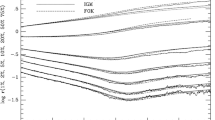Abstract
In this paper we focus our attention on small-to-intermediate \(N\)-body systems that are, initially, distributed uniformly in space and dynamically ‘cool’ (virial ratios \(Q=2T/|\varOmega|\) below \(\sim0.3\)). In this work, we study the mass segregation that emerges after the initial violent dynamical evolution. At this scope, we ran a set of high precision \(N\)-body simulations of isolated clusters by means of HiGPUs, our direct summation \(N\)-body code. After the collapse, the system shows a clear mass segregation. This (quick) mass segregation occurs in two phases: the first shows up in clumps originated by sub-fragmentation before the deep overall collapse; this segregation is partly erased during the deep collapse to re-emerge, abruptly, during the second phase, that follows the first bounce of the system. In this second stage, the proper clock to measure the rate of segregation is the dynamical time after virialization, which (for cold and cool systems) may be significantly different from the crossing time evaluated from initial conditions. This result is obtained for isolated clusters composed of stars of two different masses (in the ratio \(m_{h}/m_{l}=2\)), at varying their number ratio, and is confirmed also in presence of a massive central object (simulating a black hole of stellar size). Actually, in stellar systems starting their dynamical evolution from cool conditions, the fast mass segregation adds to the following, slow, secular segregation which is collisionally induced. The violent mass segregation is an effect persistent over the whole range of \(N\) (\(128 \leq N \leq1\mbox{,}024\)) investigated, and is an interesting feature on the astronomical-observational side, too. The semi-steady state reached after virialization corresponds to a mass segregated distribution function rather than that of equipartition of kinetic energy per unit mass as it should result from violent relaxation.













Similar content being viewed by others
Notes
The minimum spanning tree is the shortest path length which connects a certain number of points without forming closed loops.
References
Aarseth, S.J.: Gravitational \(N\)-Body Simulations: Tools and Algorithms. Cambridge Monographs on Mathematical Physics. Cambridge University Press, Cambridge (2003)
Aarseth, S.J., Lin, D.N.C., Papaloizou, J.C.B.: Astrophys. J. 324, 288 (1988)
Adams, F.C., Proszkow, E.M., Fatuzzo, M., Myers, P.C.: Astrophys. J. 641, 504 (2006)
Alessandrini, E., Cosmic-Lab Team: Mem. Soc. Astron. Ital. 87, 513 (2016)
Allison, R.J., Goodwin, S.P., Parker, R.J., de Grijs, R., Portegies Zwart, S.F., Kouwenhoven, M.B.N.: Astrophys. J. 700, 99 (2009a)
Allison, R.J., Goodwin, S.P., Parker, R.J., Portegies Zwart, S.F., de Grijs, R., Kouwenhoven, M.B.N.: Mon. Not. R. Astron. Soc. 395, 1449 (2009b)
Banerjee, S., Kroupa, P.: Mon. Not. R. Astron. Soc. 447, 728 (2015)
Binney, J., Tremaine, S.: Galactic Dynamics, 2nd edn. Princeton Series in Astrophysics. Princeton University Press, Princeton (2008)
Bonnell, I.A., Davies, M.B.: Mon. Not. R. Astron. Soc. 295, 691 (1998)
Bontemps, S., Motte, F., Csengeri, T., Schneider, N.: Astron. Astrophys. 524, 18 (2010)
Caputo, D.P., de Vries, N., Portegies Zwart, S.: Mon. Not. R. Astron. Soc. 445, 674 (2014)
Capuzzo-Dolcetta, R., Spera, M.: Comput. Phys. Commun. 184, 2528 (2013)
Capuzzo-Dolcetta, R., Spera, M., Punzo, D.: J. Comput. Phys. 236, 580 (2013)
De Marchi, G., Beccari, G., Panagia, N.: Astrophys. J. 775, 68 (2013)
Er, X.Y., Jiang, Z.B., Fu, Y.N.: Res. Astron. Astrophys. 13, 277 (2013)
Farias, J.P., Smith, R., Fellhauer, M., Goodwin, S., Candlish, G.N., Blaña, M., Dominguez, R.: Mon. Not. R. Astron. Soc. 450, 2451 (2015)
Farouki, R.T., Salpeter, E.E.: Astrophys. J. 253, 512 (1982)
Geyer, M.P., Burkert, A.: Mon. Not. R. Astron. Soc. 323, 988 (2001)
Gouliermis, D., Dapergolas, A., Lianou, S., Kontizas, E., Kontizas, M.: In: AIP Conference Proceedings, vol. 848, p. 525 (2006)
Hillenbrand, L.A., Hartmann, L.W.: Astrophys. J. 492, 540 (1998)
Hills, J.G.: Astrophys. J. 235, 986 (1980)
Kirk, H., Offner, S.S.R., Redmond, K.J.: Mon. Not. R. Astron. Soc. 439, 1765 (2014)
Lada, C.J., Margulis, M., Dearborn, D.: Astrophys. J. 285, 141 (1984)
Littlefair, S.P., Naylor, T., Jeffries, R.D., Devey, C.R., Vine, S.: Mon. Not. R. Astron. Soc. 345, 1205 (2003)
Matsumoto, M., Nishimura, T.: ACM Trans. Model. Comput. Simul. 8(1), 3 (1998)
McMillan, S., Vesperini, E., Kruczek, N.: Highlights Astron. 16, 259 (2015). doi:10.1017/S1743921314005687
McMillan, S.L.W., Vesperini, E., Portegies Zwart, S.F.: Astrophys. J. Lett. 655, 45 (2007)
Nitadori, K., Makino, J.: New Astron. 13, 498 (2008)
Plummer, H.C.: Mon. Not. R. Astron. Soc. 71, 460 (1911)
Raboud, D.: In: Morrell, N.I., Niemela, V.S., Barbá, R.H. (eds.) Revista Mexicana de Astronomia y Astrofisica Conference Series, vol. 8, p. 107 (1999)
Raboud, D., Mermilliod, J.-C.: Astron. Astrophys. 333, 897 (1998)
Rossi, L.J., Hurley, J.R., Bekki, K.: Mon. Not. R. Astron. Soc. 468, 4441 (2017)
Schmeja, S., Klessen, R.S.: Astron. Astrophys. 449, 151 (2006)
Shao, Z., Xie, X., Chen, L., Zhong, J., Hou, J., Lin, C.-C.: In: Charbonnel, C., Nota, A. (eds.) Formation, Evolution, and Survival of Massive Star Clusters. IAU Symposium, vol. 316, p. 265 (2017)
Yu, J., Puzia, T.H., Lin, C., Zhang, Y.: Astrophys. J. 840, 91 (2017)
Acknowledgements
We thank the referee, Mirek Giersz, for his comments and suggestions which greatly helped us to improve the paper.
Author information
Authors and Affiliations
Corresponding author
Rights and permissions
About this article
Cite this article
Spera, M., Capuzzo-Dolcetta, R. Rapid mass segregation in small stellar clusters. Astrophys Space Sci 362, 233 (2017). https://doi.org/10.1007/s10509-017-3209-6
Received:
Accepted:
Published:
DOI: https://doi.org/10.1007/s10509-017-3209-6




